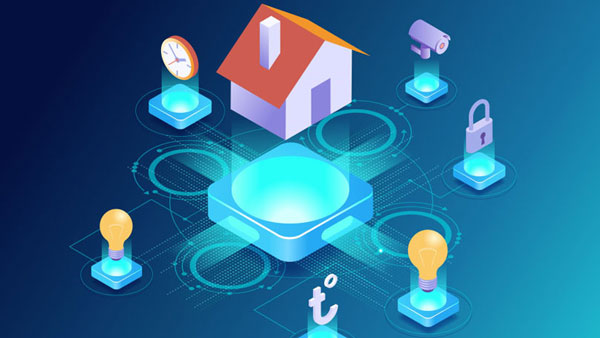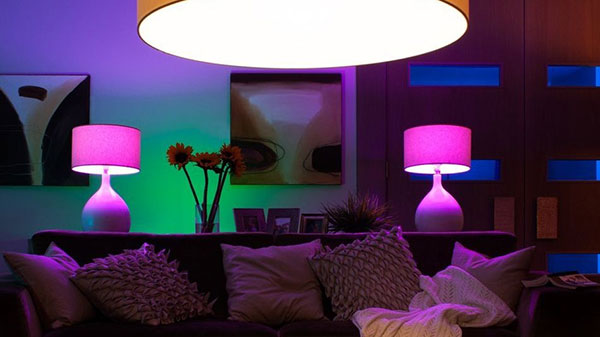A decade ago, the “smart home” used to be the exclusive domain of the hobbyist—someone who knew enough programming and electrical work to automate lights, yard sprinklers, and more. Fast-forward ten years, and that’s changed. Today, transforming your home into a “smart home” is easier and more accessible than ever, with technology designed to be simple to install, operate, and connect to smart speakers such as the Amazon Echo and Google Home. Best of all, making these upgrades doesn’t have to cost a fortune. In this article, we’ll review the best places to start making changes and how you can save money—both now and in the future.

Start With The Smart Home Essentials
If you’re just starting your smart home journey, a good place to start is with upgrades that will help you save money down the road. Changing out your thermostat, lights, and electrical outlets is not only relatively inexpensive, but the energy savings can also eventually pay back the initial investment.
Thermostat
Smart thermostats—also known as “programmable thermostats”—represent a major technological upgrade over traditional manual models. Smart thermostats allow homeowners to schedule the temperature setting of their home ahead of time and then control it throughout the day, from anywhere, using their smartphone. This “set-it-and-forget-it” model helps you cut down on your energy bills, since your air conditioner, heat pump, or furnace can be set to run less intensively during the times you’re away from home. Some models even feature “learning” technology, which can identify usage trends over time and suggest ways to save even more.
Most of these thermostats retail between $80 and $200. Before purchasing, be sure to check with your utility company: many utilities are offering either instant rebates or extended savings as a part of enrolling your new thermostat in an energy-saver program.
Lights
“Smart” lighting is one of the very first smart home projects many homeowners start. Our recommendation? Skip buying “smart bulbs” and instead purchase a smart electrical outlet that you can pair with the lamps and bulbs you already have—especially if you already have switched your home over to energy-efficient LED / CFL bulbs. These electrical outlets are not only more versatile—they can be used for far more than just lamps—but are often less expensive than smart bulbs, saving you money upfront.
Beyond the convenience of being able to turn off your lights with a tap of your smartphone (or your voice, if you have a smart speaker setup), smart lighting can help you save money on your electric bills by ensuring that your lights are always off at night or when you’re away from home.

Expand Into New Areas of Smart Home Tech
Once you’ve installed the essential items such as a smart speaker and thermostat, it’s time to take a look at other smart home tools that will improve the quality of life inside your home.
Alarm clocks
Once at risk to disappear completely with the rise of smartphones, the bedside alarm clock is making a big comeback thanks to integrated smart home features. Many alarm clocks not only can charge multiple devices, but now come equipped with voice controls and touch-screen displays so that you can check tomorrow’s calendar or read the news before going to bed.
We also recommend giving “wakeup light” alarm clocks a closer look. These clocks gradually increase the amount of light in the room as you wake up, simulating a sunrise. This is far from a gimmick: multiple studies into human sleep have demonstrated that sunrise simulation helps people wake up more gradually and peacefully, instead of jumping out of bed to the sudden shock of a ringing or buzzing alarm.
Window shades
A great complement to your smart thermostat, smart shades can play a key role in helping your home keep cool in the summer. Year-round, smart shades also improve your home’s privacy. These window shades can be programmed to move up-and-down at certain times, and their smartphone integration means they can be controlled from anywhere. All this means no more forgetting to close the blinds before you leave for work in the morning!
Building the ultimate kitchen
With the amount of time homeowners spend in the kitchen, it shouldn’t be a huge surprise that this space of the home serves as the front lines of smart home innovation. From smart sous vide devices to smart microwaves, there’s something for everyone—whether you’re an accomplished home chef or just looking to make a quick meal for the family. On that latter note, one recent tool you should know about is the Perfect Bake Pro. This is a smart scale that integrates with your smartphone and helps you pour out the exact amount of ingredients for any recipe in the app’s extensive library. It represents an easier way to double that batch of cookies.
What’s next?
All of the smart home gadgets and features listed above are the tip of the iceberg when it comes to building a smart home. Homeowners can take things even further with smart doorbells and security systems to smart appliances. Our recommendation is that you start with the essentials and then slowly chip away at other upgrades as necessary. After all, almost every home could benefit from a smart thermostat, while something like a smart french press coffee maker probably has a more niche audience.
Find Ways to Save on Other Smart Upgrades
As we’ve learned so far, upgrading your home to be smarter doesn’t have to cost a fortune. Here are two other great ways to cut down on your upfront costs:
Wait for annual sales
Many smart technology manufacturers tie some of their best prices to Black Friday deals, knowing that many shoppers are eager to buy smart home tools as holiday gifts. For example, the prices for smart speakers—such as the Google Home or Amazon Echo—are often slashed by up to 50% on Black Friday. The same thing goes for Nest Thermostats, Ring Video Doorbells, and other smart home upgrades. If you want to save money while upgrading your home, it might not be a bad idea to wait for these online sales to roll around.
DIY installation
While it might be best to bring in a professional to help with the installation of some advanced smart home systems—such as an outdoor security system that needs its own weatherproofed electrical line—many other smart home gadgets can be installed by the homeowner. Most smart thermostats come with easy-to-understand instructions and video tutorials, while the installation of smart doorbells and locks is not that much different from how the manual versions are installed.
When in doubt, you can always bring in a professional, but tackling some of the installation on your own will reduce your overall costs significantly.




















